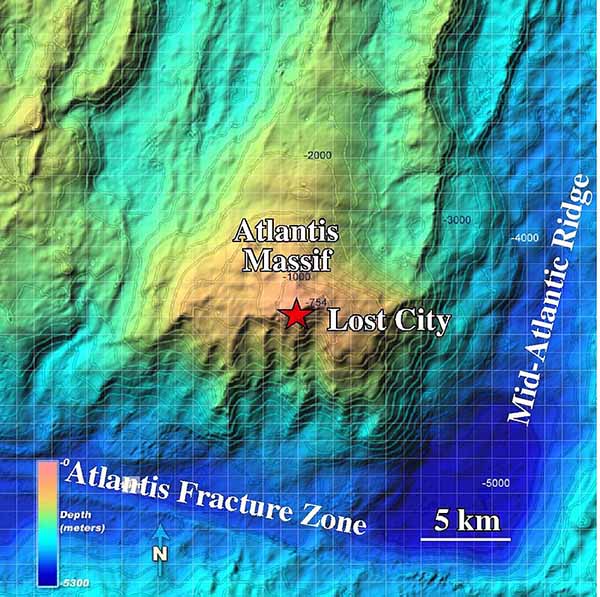
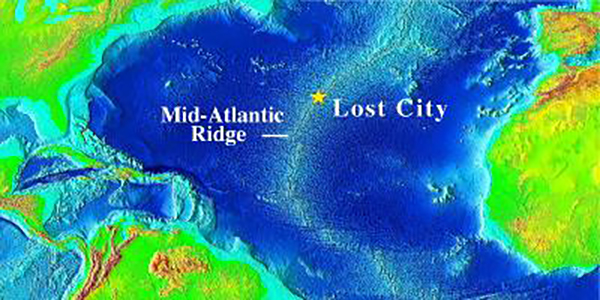
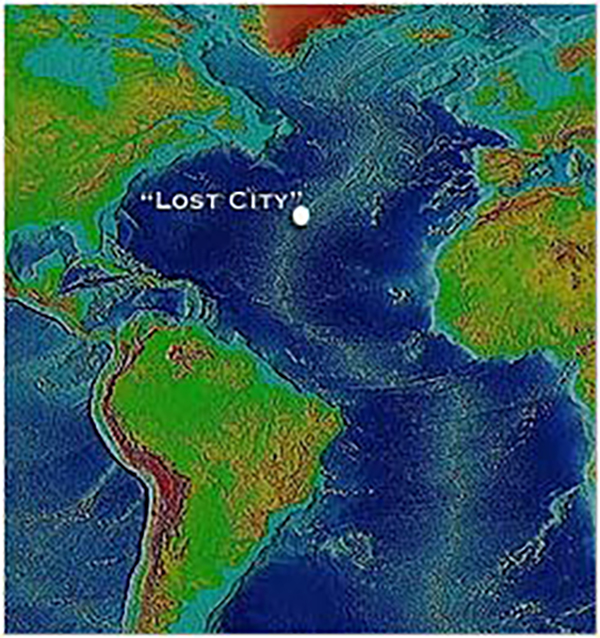
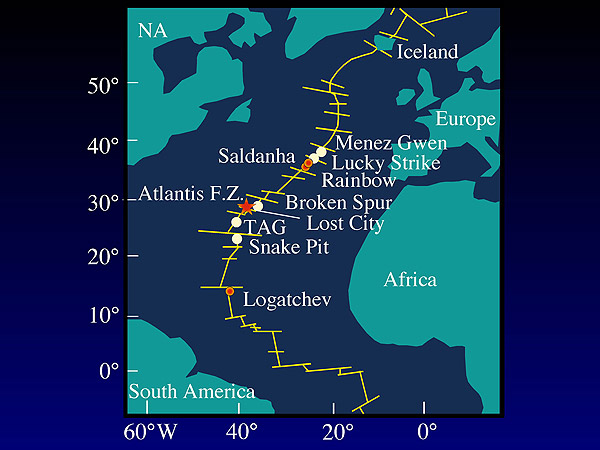
Mid-Atlantic Ridge





Mid-Atlantic Ridge

Titles about a Lost City make you wonder what lies ahead as you read on. This lost city caught my attention because it arrives at the intersection between the Mid-Atlantic Ridge and the Atlantis Transform Fault, in the Atlantic Ocean. Did life begin here? Thoughts of turning this into a fiction or science fiction adventure crossed my mind, but that's not exactly what it's about. We have to wonder what's buried for all time under the ocean floor that is now surfacing to change the destiny of planet Earth and humanity.
Speculation has been offered that ancient versions of similar alkaline hydrothermal vents in the seas of a young Earth were the birthplace of all life, constituting the planet's original abiogenesis. The free hydrogen gas produced, metallic catalysts consistent with an iron-sulfur world theory, micro-cellular physical structure of the towers, and available hydrothermal energy might plausibly have provided an environment for the beginnings of non-photosynthetic energy cycles common to the most primitive microorganisms and organic molecule creation. Microscopic structures in such alkaline vents show interconnected compartments that provide an ideal hatchery for the "Origin of Life".
These alkaline hydrothermal vents also continuously generate acetyl thioesters, providing both the starting point for more complex organic molecules and the energy needed to produce them. However, this notion was rejected by Japanese researchers from Earth-Life Science Institute (ELSI), Tokyo Institute of Technology. They showed that because of the high free energy change of thioester hydrolysis and their corresponding low equilibrium constants, it is unlikely that these species could have accumulated abiotically to any significant extent in the Lost City fields.
The conditions at Lost City are of particular concern because of the different types of extremophiles present. Lost City microbes are polyextremophiles, fitting the description of alkaliphiles, moderate piezophiles, and thermophiles in an environment without sunlight. The combination of different extremophile elements suggests that Lost City organisms are more extreme than at other locations, making them particularly interesting subjects of study on the requirements for life.
Given the only requirements for serpentinization are olivine and seawater, locations like Lost City could theoretically exist on extraterrestrial bodies with liquid water such as Europa and Enceladus.
The Lost City Hydrothermal Field, often referred to simply as Lost City, is an area of marine alkaline hydrothermal vents located on the Atlantis Massif at the intersection between the Mid-Atlantic Ridge and the Atlantis Transform Fault, in the Atlantic Ocean.
It is a long-lived site of active and inactive ultramafic-hosted serpentinization, abiotically producing many simple molecules such as methane and hydrogen which are fundamental to microbial life. As such it has generated scientific interest as a prime location for investigating the origin of life on Earth and other planets similar to it.
Lost City is located in the North Atlantic Ocean on the seafloor mountain Atlantis Massif, which is approximately the size of Mount Rainier. The site is described as a long-lived vent field, estimated to be older than 120,000 years by radiocarbon dating the oldest chimney deposits of the field. However, this is significantly younger than the age of the Atlantis Massif itself, which may be as old as two million years. Lost City is located on a shelf approximately 70 metres (230 ft) below the massif summit at a depth of around 750-900 m (2,460-2,950 ft), with an approximate area of 500 square metres (5,400 sq ft). The massif itself may have originated in a similar manner to many other ocean core complexes.
Lost City is a location dominated by steep cliffs to the south, chimneys, and mounds of carbonate material deposited from chimneys that collapse as they age. Breccia, gabbros, and peridotites are dominating rock types as one maneuvers away from the field, which are prone to mass wasting as the bathymetry steepens. Mass-wasting events of the past are evident by bountiful scarps on the slope of the massif. Rubble tends to accumulate at areas no steeper than 60 degrees bounding the field, and can undergo lithification depending on how far it is located from Lost City.
Of the 30 active and inactive vent chimneys, Posidon is the largest and most-studied within the vent field. Posidon stands about 60 metres (200 ft) tall and 100 metres (330 ft) wide and has numerous orifices venting hot fluids. The vent nicknamed Beehive, for its distinct shape upon discovery, is about one meter tall and located on the south side of Posidon. Furthermore, the IMAX tower stands approximately 8 metres (26 ft) tall on the north side of Posidon, though the chimney has stalagmite-like growths that are as tall as 30 metres (98 ft). IMAX has a large flange which catches hot, escaping fluid and has a very apparent biofilm acting within it.
Other chimneys, such as Ryan and Nature to the east of Posidon, also have flange and beehive-like structures, though they are significantly smaller and vent significantly less than Posidon. Several inactive vents are located about 100 metres (330 ft) south of Posidon, though they only stand a few meters tall.
Since the location of the massif is upon a slow to ultra-slow spreading center, there is a large number of faults that run through the vent field. Many faults, especially at the south side, are high-angle normal faults that can be concealed by debris. Most of the vents found tend to run from east to west, likely due to the orientation of fault lines under the field.
Two extinct fields are located about 300 metres (980 ft) west and 450 metres (1,480 ft) southwest of the central vent field at depths of 1,000 metres (3,300 ft) or more. They have inactive vents similar in profile to Posidon with a talus (scree) deposit separating them from the central vent field, though they have not been as actively explored. It is hypothesized from the ages of samples collected that hot fluid flow migrated from the south to the north where Posidon currently resides.
Strontium, carbon, and oxygen isotope data and radiocarbon ages document at least 30,000 years of hydrothermal activity driven by serpentinization reactions at Lost City, making Lost City older than all known black smoker vents by at least two orders of magnitude.
Alkaline hydrothermal vents like those of Lost City are only superficially related to volcanic black smoker vents; the two types of vent are perhaps better described by their differences than their similarities. Though both types are often found near oceanic spreading centers, alkaline hydrothermal vents are not created by volcanic processes. They release methane and diatomic hydrogen into the surrounding water; they do not produce significant amounts of carbon dioxide, hydrogen sulfide, or metals, which are the major outputs of volcanic black smoker vents. The temperature and pH of water surrounding the two types of vent is also significantly different.
The Atlantis Massif is described as an ultramafic oceanic core complex of the Mid-Atlantic Ridge, with upper mantle rock being exposed to seawater through faulting from tectonic extension associated with oceanic spreading centers. The spreading half-rate is approximated to about 12 mm/yr, classifying it as a slow-spreading ridge. Seismic events of Richter magnitude 4 and 4.5 have been detected at the massif.
The dominant minerals found at Lost City are ultramafic, composed primarily of olivine and pyroxene with very little silica content. Peridotite (primarily spinel harzburgite) minerals undergo serpentinization and form magnetite and serpentine minerals. Because little to no carbon dioxide or metals are released in the venting fluids, Lost City bears the appearance of a non-smoker, with few particulates to give a smoky appearance.
Once pore waters have permeated the surface and return to the surface, aragonite, brucite, and calcite chimneys are formed as calcium carbonates precipitate out of solution. Younger chimneys are primarily brucite and aragonite, being white and flaky in appearance. As vents mature, porosity decreases as precipitates clog fluid pathways. Mineral compositions change with aragonite succeeded by calcite and brucite being removed through dissolution, and the chimneys darken to a grey or brown color.
On the side of the Atlantis Transform Fault, the Atlantis Massif wall terminates approximately 740 metres (2,430 ft) below sea level, where rock types deform to various mylonitic rocks with deformation fabric minerals of talc, tremolite, and ribbon serpentine

Olivine, the mineral responsible for Lost City's serpentinization
Lost City is an exemplary location for the study of abiotic methanogenesis and hydrogenesis, as serpentinization reactions produce methane and hydrogen. The reactions are exothermic and warm the surrounding waters via reaction heating, though fluid temperatures are still relatively low (40° - 90°C) when compared to other hydrothermal systems. Furthermore, local pH is increased to values of over 9, which enables calcium carbonate precipitation. Since serpentinization is particularly extensive, carbon dioxide concentrations are also very low. Low temperature, carbon dioxide concentrations, as well as the low hydrogen sulfide and metal content of the plume make the vents more difficult to identify from CTD measurements or optical backscatter methods.
Scientists drill longest-ever piece of Earth's mantle from underwater mountain near 'Lost City' Live Science - August 8, 2024

Researchers have drilled the deepest-ever sample of rocks from Earth's mantle, penetrating 0.7 mile (1.2 kilometers) in the Mid-Atlantic Ridge, where the seafloor is spreading apart. So far, the team has found that rather than traveling vertically, melts seem to move obliquely, traveling in a diagonal inclined path toward the surface.
Underwater terrain of the Lost City Hydrothermal Fields
Close to the summit of an underwater mountain west of the Mid-Atlantic Ridge, a jagged landscape of towers rises from the gloom. Their creamy carbonate walls and columns appear ghostly blue in the light of a remotely operated vehicle sent to explore. They range in height from tiny stacks the size of toadstools to a grand monolith standing 60 meters (nearly 200 feet) tall. This is the Lost City.
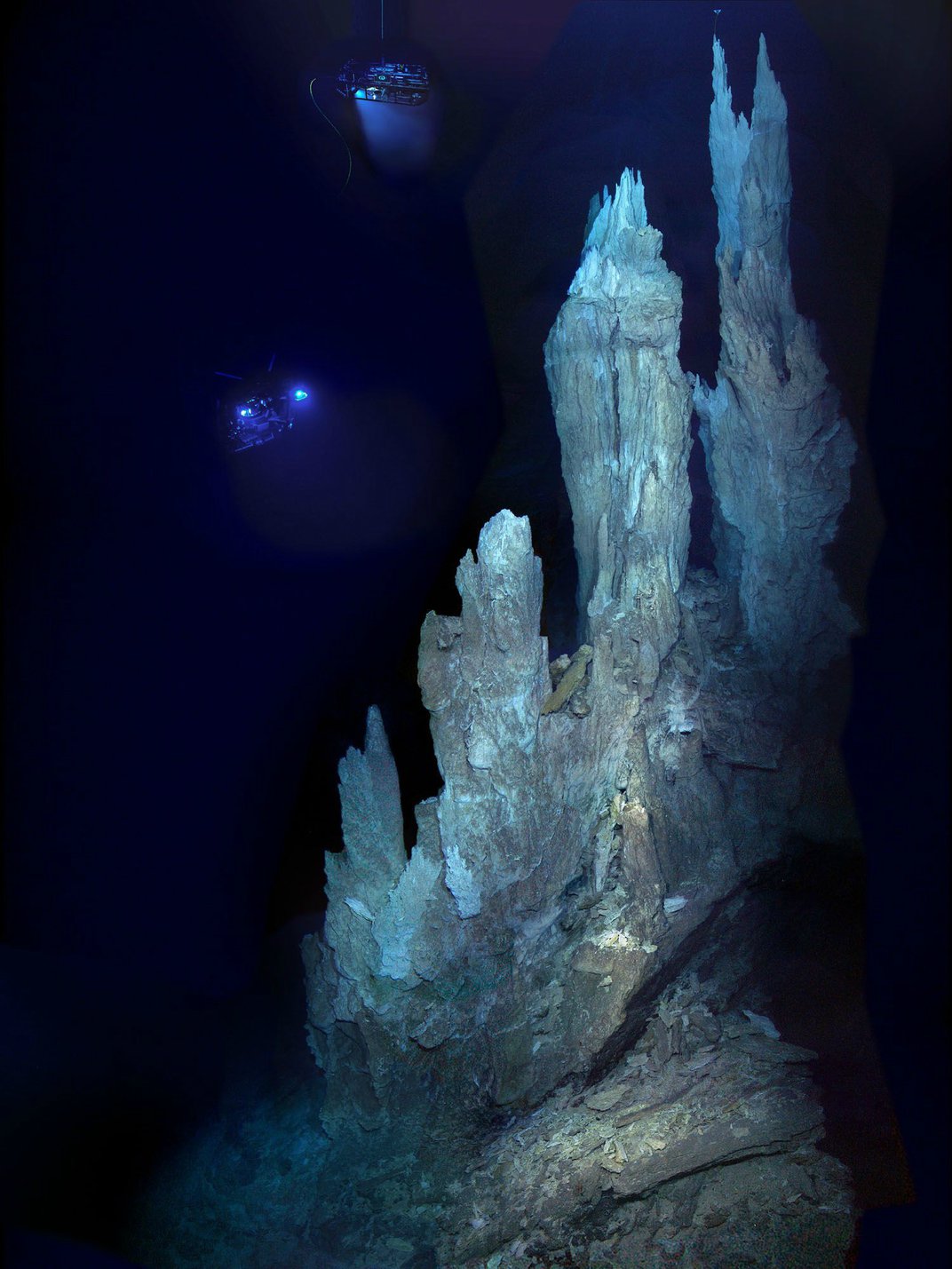
A remotely operated vehicle shines a light on the spires of the Lost City.
Discovered by scientists in 2000, more than 700 meters (2,300 feet) beneath the surface, the Lost City Hydrothermal Field is the longest-lived venting environment known in the ocean. Nothing else like it has ever been found.
For at least 120,000 years and maybe longer, the upthrusting mantle in this part of the world has reacted with seawater to puff hydrogen, methane, and other dissolved gases out into the ocean.
In the cracks and crevices of the field's vents, hydrocarbons feed novel microbial communities even without the presence of oxygen.
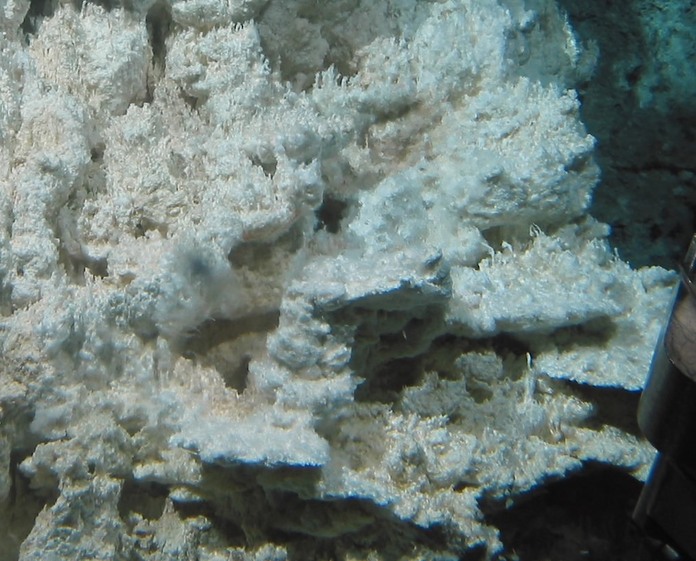
Chimneys spewing gases as hot as 40° C (104°F) are home to an abundance of snails and crustaceans. Larger animals such as crabs, shrimp, sea urchins, and eels are rare, but still present.
Despite the extreme nature of the environment, it appears to be teeming with life, and researchers think it's worth our attention and protection.
While other hydrothermal fields like this one probably exist elsewhere in the world's oceans, this is the only one remotely operated vehicles have been able to find thus far.
The hydrocarbons produced by the Lost City's vents were not formed from atmospheric carbon dioxide or sunlight, but by chemical reactions on the deep seafloor.
Because hydrocarbons are the building blocks of life, this leaves open the possibility that life originated in a habitat just like this one. And not just on our own planet.
"This is an example of a type of ecosystem that could be active on Enceladus or Europa right this second," microbiologist William Brazelton told The Smithsonian in 2018, referring to the moons of Saturn, Jupiter, and maybe Mars in the past.
Unlike underwater volcanic vents called black smokers, which have also been named as a possible first habitat, the Lost City's ecosystem doesn't depend on the heat of magma.
Black smokers produce mostly iron- and sulfur-rich minerals, whereas the Lost City's chimneys produce up to 100 times more hydrogen and methane.
The calcite vents of the Lost City are also much, much larger than black smokers, which suggests they've been active for longer.
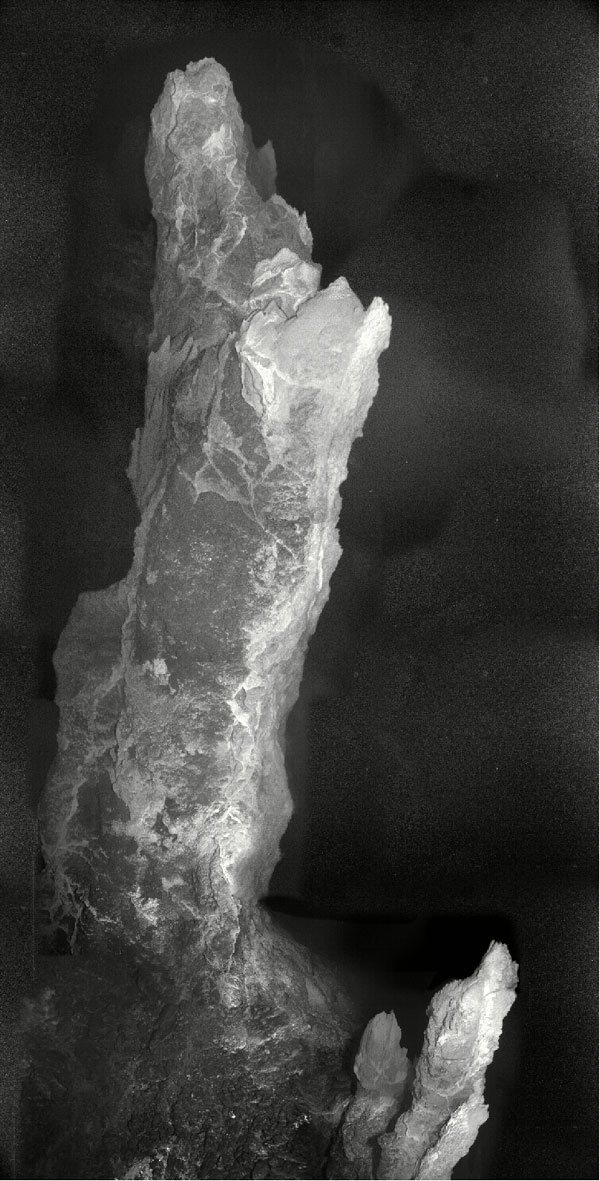
Nine-meter-high chimney in the Lost City.
The tallest of the monoliths is named Poseidon, after the Greek god of the sea, and it stretches more than 60 meters high. Just northeast of the tower, meanwhile, is a cliffside with short bursts of activity.
Researchers at the University of Washington describe the vents here as 'weeping' with fluid to produce "clusters of delicate, multi-pronged carbonate growths that extend outward like the fingers of upturned hands". Unfortunately, scientists aren't the only ones beckoned by that unusual terrain.
In 2018, it was announced that Poland had won the rights to mine the deep sea around The Lost City. While there are no precious resources to be dredged up in the actual thermal field itself, the destruction of the city's surroundings could have unintended consequences. Any plumes or discharges, triggered by the mining, could easily wash over the remarkable habitat, scientists warn.
Some experts are therefore calling for the Lost City to be listed as a World Heritage site, to protect the natural wonder before it's too late. For tens of thousands of years, the Lost City has stood as a testament to the enduring force of life.
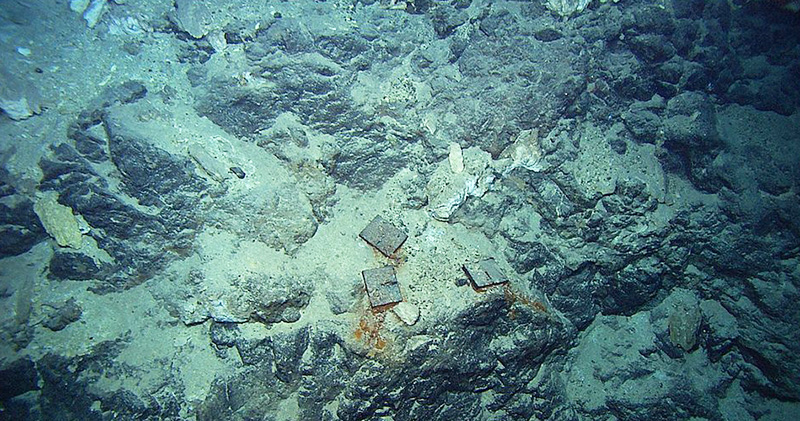
The towering structures of the Lost City are nearly pure carbonate, the same material as limestone in caves. A lost city at the bottom of the ocean contains chemical traces that suggests it could have been the cradle of life on Earth. Some believe the right ingredients for life made their way from outer space.
Darwin thought it emerged in a "warm little pond" and others have looked for answers on the sea floor. Now evidence to back the latter submarine idea has emerged from the "Lost City" which lies at a depth of 2,600 feet, where creamy white to grey spires, pinnacles and 18 story chimneys teem with microscopic marine life, as a volcanic system on the Atlantic sea floor that gradually pushes America and Britain apart.
The temperature and composition of fluids from a group of underwater hot springs there that are heated by the slow cooling of the underlying rocks, called a hydrothermal vent field, are similar to those predicted to have occurred during the early years of life on Earth.
The Lost City hydrothermal vent field is about 2,300 miles east of Florida, on the Mid-Atlantic Ridge. Microorganisms there thrive in alkaline vent fluids, some nearly as caustic as liquid drain cleaner. This contrasts to the previously studied black-smoker vents where organisms have adjusted to acidic water.
Lost City microbes dine on methane and hydrogen instead of the carbon dioxide that is the key energy source for life at black-smoker vents. The towering structures of the Lost City are nearly pure carbonate, the same material as limestone in caves. The structures drape the cliffs at Lost City and range from the size of tiny toadstools to the 18-story column, named Poseidon, that dwarfs most known black smoker vents by at least 100 feet.
The field was named Lost City in part because it is on top of a submerged mountain named Atlantis and was discovered by chance during an expedition on board the research vessel Atlantis.
LA PALMA CANARY ISLAND THEORY
ATLANTIC OCEAN ANOMALIES AND THEMES